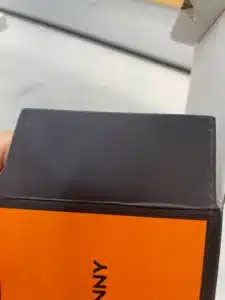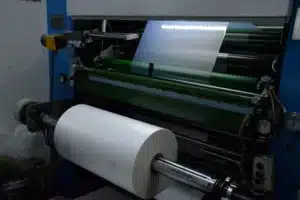Are you frustrated with mysterious white spots ruining your high-quality print jobs? These defects can destroy your brand’s reputation and waste valuable resources.
White powder spots are small, visible defects appearing as white or light-colored dots on printed materials, primarily caused by excessive drying powder, incompatible pre-coated films, contamination during lamination, and environmental factors like dust and moisture.
Understanding these printing defects is crucial for maintaining professional print quality. Moreover, knowing how to prevent them will save you time, money, and client relationships in the long run.
What Are White Powder Spots and Why Do They Matter?
Have you ever noticed small white dots scattered across your beautifully printed dark packaging? These annoying imperfections can turn professional work into rejected prints.
White powder spots are small, visible defects on printed materials that appear as white or light-colored dots, streaks, or patches, especially noticeable on dark or glossy surfaces where they significantly degrade print quality.
Understanding the Visual Impact
These spots become particularly problematic on premium packaging materials. Furthermore, they’re most visible on:
- Dark backgrounds – Black or deep-colored prints show spots prominently
- Glossy surfaces – High-shine finishes highlight imperfections
- Solid color areas – Large blocks of color reveal even tiny spots
- Metallic finishes – Reflective surfaces amplify defect visibility
The Business Impact
These defects create serious consequences for printing operations. Additionally, the financial impact includes:
| Impact Type | Cost Factor | Prevention Benefit |
|---|---|---|
| Reprints | Material + Labor | 100% Cost Savings |
| Waste | Paper + Ink | Reduced Material Loss |
| Client Relations | Lost Business | Maintained Reputation |
| Time Delays | Production Schedule | On-time Delivery |
Preventing these spots is essential because they separate freshly printed materials from sticking together. However, controlling the quantity and application of protective measures becomes crucial for quality control.
How Does Drying Powder Cause White Spots?
Does your offset printing process leave mysterious white particles on finished products? Drying powder, while essential, often becomes the primary culprit behind these defects.
Drying powder causes white spots when applied excessively or incompletely removed, leaving residual particles on prints that appear as visible white defects, particularly problematic on dark or glossy surfaces.
The Purpose and Problems of Drying Powder
Drying powder serves a vital function in offset printing. Specifically, it prevents wet ink from smudging and helps sheets separate during the printing process. However, problems arise when:
- Excessive application – Too much powder creates visible residue
- Uneven distribution – Inconsistent coverage leaves concentrated spots
- Incomplete removal – Residual particles remain after processing
- Wrong powder type – Incompatible formulations don’t integrate properly
Environmental Factors Affecting Powder Performance
Environmental conditions significantly impact how drying powder behaves. Moreover, these factors influence spot formation:
"Humidity levels above 60% can cause drying powder to clump and create uneven application, leading to concentrated white spots on finished prints."
Identifying Powder-Related Spots
Recognizing powder-caused defects helps target prevention efforts. Additionally, these spots typically show these characteristics:
| Characteristic | Powder Spots | Other Defects |
|---|---|---|
| Shape | Irregular, granular | Round, uniform |
| Distribution | Random clusters | Pattern-based |
| Texture | Slightly raised | Flat appearance |
| Removal | Can be brushed off | Permanently embedded |
Why Do Pre-Coated Films Create Printing Problems?
Are you experiencing adhesion issues with your specialty printing materials? Pre-coated films, while offering unique finishing options, can create unexpected white spot challenges.
Pre-coated films cause white spots when their coating proves incompatible with printing inks or processes, resulting in poor adhesion, uneven surfaces, and visible defects that compromise print quality.
Understanding Pre-Coated Film Technology
Pre-coated films represent advanced printing substrates with factory-applied coatings. Furthermore, these materials offer benefits but require careful handling:
- Enhanced durability – Protective coatings extend print life
- Special effects – Unique finishes create premium appearance
- Moisture resistance – Protective barriers prevent damage
- UV protection – Coatings prevent color fading
Compatibility Issues Leading to Defects
The primary challenge with pre-coated films involves material compatibility. Additionally, common problems include:
"Ink adhesion failures on pre-coated films often result from chemical incompatibility between the coating and printing inks, creating white spots where proper bonding fails to occur."
Storage and Handling Factors
Proper storage significantly affects pre-coated film performance. Moreover, these conditions prevent defects:
| Storage Factor | Optimal Condition | Problem Prevention |
|---|---|---|
| Temperature | 65-75°F (18-24°C) | Prevents coating degradation |
| Humidity | 45-55% RH | Avoids moisture absorption |
| Dust Protection | Sealed containers | Eliminates contamination |
| Light Exposure | Dark storage | Prevents UV degradation |
Testing and Quality Assurance
Preventing pre-coated film problems requires systematic testing. Consequently, establishing test protocols helps identify compatibility issues before full production runs.
How Does Lamination Contribute to White Spot Formation?
Is your lamination process creating unexpected defects on your premium packaging? Lamination, while protective, can introduce or worsen white spot problems when not properly executed.
Lamination contributes to white spots by trapping dust, moisture, or drying powder residue between layers, creating visible defects that become permanently sealed within the finished product.
The Lamination Process and Defect Formation
Lamination applies protective film layers to printed materials. However, the process can create problems when:
- Pre-existing contamination gets sealed between layers
- Moisture becomes trapped during application
- Air bubbles create surface irregularities
- Adhesive inconsistencies cause bonding failures
Critical Control Points in Lamination
Successful lamination requires attention to multiple factors. Additionally, these control points prevent defects:
- Surface preparation – Clean all dust and debris
- Moisture control://makerslam.com/blog/moisture-absorption-effects-on-industrial-laminates) control – Ensure complete ink drying
- Film selection – Choose compatible materials
- Pressure application – Maintain consistent force
- Temperature control – Optimize heat settings
Pre-Lamination Quality Checks
Implementing quality checks before lamination prevents defect amplification. Furthermore, essential checks include:
| Check Point | What to Inspect | Action Required |
|---|---|---|
| Surface cleanliness | Dust, particles | Clean with soft brush |
| Ink drying | Wet areas, tackiness | Allow additional drying time |
| Color consistency | Uneven areas | Reprint if necessary |
| Paper condition | Moisture, warping | Condition materials properly |
What Other Factors Cause White Powder Spots?
Beyond the primary causes, are there hidden factors creating white spots in your printing operation? Several environmental and equipment-related issues can contribute to these persistent defects.
Other factors causing white spots include dust contamination from equipment or environment, moisture-related problems from humidity control failures, and equipment maintenance issues that introduce particles or uneven ink application.
Environmental Contamination Sources
Printing environments contain multiple contamination sources. Moreover, common sources include:
- Paper dust – Generated during cutting and handling
- Ambient dust – From ventilation systems and foot traffic
- Static electricity – Attracts airborne particles to prints
- Chemical residues – From cleaning agents and maintenance
Equipment-Related Causes
Poorly maintained equipment significantly contributes to white spot formation. Additionally, these equipment issues create problems:
Cleaning and Maintenance Protocols
Establishing regular maintenance prevents equipment-related defects. Furthermore, effective protocols include:
| Equipment Area | Cleaning Frequency | Method |
|---|---|---|
| Printing rollers | Daily | Solvent cleaning |
| Dust collection | Weekly | Filter replacement |
| Air filtration | Monthly | System inspection |
| Work surfaces | After each job | Tack cloth wiping |
Moisture Control Strategies
Humidity significantly affects printing quality and defect formation. Consequently, proper moisture control includes:
- Humidity monitoring – Maintain 45-55% relative humidity
- Temperature control – Keep consistent 68-72°F (20-22°C)
- Air circulation – Ensure proper ventilation
- Material conditioning – Allow papers to acclimate
How to Prevent White Powder Spots from Drying Powder?
Ready to eliminate drying powder problems from your printing operation? Implementing proper powder management techniques will dramatically reduce white spot defects and improve print quality.
Preventing drying powder spots requires careful application control, thorough removal procedures, environmental management, and proper equipment maintenance to ensure minimal residue remains on finished prints.
Optimal Powder Application Techniques
Proper application starts with the right equipment and techniques. Additionally, best practices include:
- Calibrated dispensers – Use equipment with precise control
- Thin, even layers – Apply minimal effective amounts
- Consistent coverage – Maintain uniform distribution
- Quality powder – Use appropriate mesh sizes and formulations
Effective Removal Methods
Complete powder removal requires systematic approaches. Furthermore, proven methods include:
- Soft brush removal – Use anti-static brushes
- Compressed air – Apply controlled air pressure
- Vacuum systems – Remove loose particles
- Tack cloth finishing – Final surface cleaning
Application Equipment Optimization
Equipment settings significantly impact powder performance. Moreover, optimal settings include:
| Parameter | Recommended Setting | Quality Impact |
|---|---|---|
| Flow rate | 2-4 grams/minute | Even coverage |
| Pressure | 15-20 PSI | Consistent application |
| Mesh size | 200-400 mesh | Appropriate particle size |
| Application speed | Match press speed | Uniform distribution |
Environmental Controls for Powder Management
Environmental conditions affect powder behavior and removal efficiency. Consequently, ideal conditions include:
- Low humidity – Below 50% relative humidity
- Controlled airflow – Minimize drafts during application
- Clean workspace – Regular housekeeping
- Static control – Anti-static measures
How to Prevent Issues During Lamination?
Want to achieve flawless lamination without white spot defects? Following proper lamination procedures and quality controls will ensure professional results every time.
Preventing lamination issues requires thorough pre-lamination preparation, proper material selection, controlled application conditions, and systematic quality checks throughout the process.
Pre-Lamination Preparation Steps
Successful lamination begins with thorough preparation. Additionally, essential steps include:
- Complete ink drying – Allow 24-48 hours minimum
- Surface cleaning – Remove all dust and particles
- Material conditioning – Acclimate to room conditions
- Quality inspection – Check for existing defects
Material Selection and Compatibility
Choosing compatible materials prevents adhesion problems. Furthermore, selection criteria include:
- Film thickness – Match to substrate requirements
- Adhesive type – Ensure ink compatibility
- Clarity level – Consider final appearance needs
- Temperature resistance – Match process requirements
Process Control Parameters
Maintaining consistent process parameters ensures quality results. Moreover, critical controls include:
| Parameter | Optimal Range | Quality Impact |
|---|---|---|
| Temperature | 180-220°F (82-104°C) | Proper adhesion |
| Pressure | 300-500 PSI | Even bonding |
| Speed | 15-30 FPM | Complete activation |
| Tension | Light, consistent | No wrinkles |
Quality Monitoring During Lamination
Continuous monitoring prevents defects from progressing. Additionally, monitoring points include:
- Film feed consistency – Watch for wrinkles or bubbles
- Temperature stability – Monitor heat distribution
- Pressure uniformity – Check roller contact
- Speed synchronization – Ensure matching rates
Post-Lamination Quality Checks
Final quality assessment ensures defect-free products. Furthermore, inspection criteria include:
- Adhesion strength – Test bond quality
- Surface clarity – Check for haziness
- Defect identification – Mark problem areas
- Trimming quality – Verify clean edges
How to Prevent Pre-Coated Film Problems?
Struggling with pre-coated film compatibility issues? Implementing proper selection, testing, and handling procedures will eliminate most film-related white spot problems.
Preventing pre-coated film problems requires careful material selection, compatibility testing, proper storage conditions, and systematic quality control throughout the printing process.
Material Compatibility Testing
Thorough compatibility testing prevents production failures. Additionally, testing protocols include:
- Ink adhesion tests – Check bonding strength
- Color matching – Verify appearance consistency
- Durability testing – Assess long-term performance
- Processing trials – Test full production conditions
Supplier Quality Assurance
Working with reliable suppliers ensures consistent material quality. Furthermore, supplier requirements include:
- Quality certifications – ISO standards compliance
- Batch consistency – Uniform material properties
- Technical support – Application guidance
- Sample availability – Pre-production testing materials
Storage and Handling Best Practices
Proper storage preserves film quality and prevents defects. Moreover, storage requirements include:
| Storage Factor | Requirement | Defect Prevention |
|---|---|---|
| Temperature | 65-75°F (18-24°C) | Prevents warping |
| Humidity | 45-55% RH | Avoids moisture absorption |
| Light protection | Dark storage | Prevents degradation |
| Dust control | Sealed packaging | Eliminates contamination |
Application Technique Optimization
Proper application techniques ensure optimal film performance. Consequently, best practices include:
- Clean substrates – Remove all contamination
- Controlled pressure – Apply consistent force
- Even temperature – Maintain uniform heat
- Proper timing – Allow adequate dwell time
Troubleshooting Common Film Issues
Identifying and resolving film problems quickly prevents waste. Additionally, common solutions include:
- Poor adhesion – Increase temperature or pressure
- Surface defects – Improve cleaning procedures
- Color variations – Check film batch consistency
- Edge lifting – Verify proper sealing
Get Premium Finishing For Your Designs At OPACK
Looking for a reliable and nice price supplier? OPACK is your trusted partner for creating stunning designs that leave a lasting impression and add elegance and sophistication to your packaging. Contact us now to order.
Conclusion
White powder spots result from drying powder excess, pre-coated film incompatibility, lamination contamination, and environmental factors—all preventable through proper techniques and quality control.











